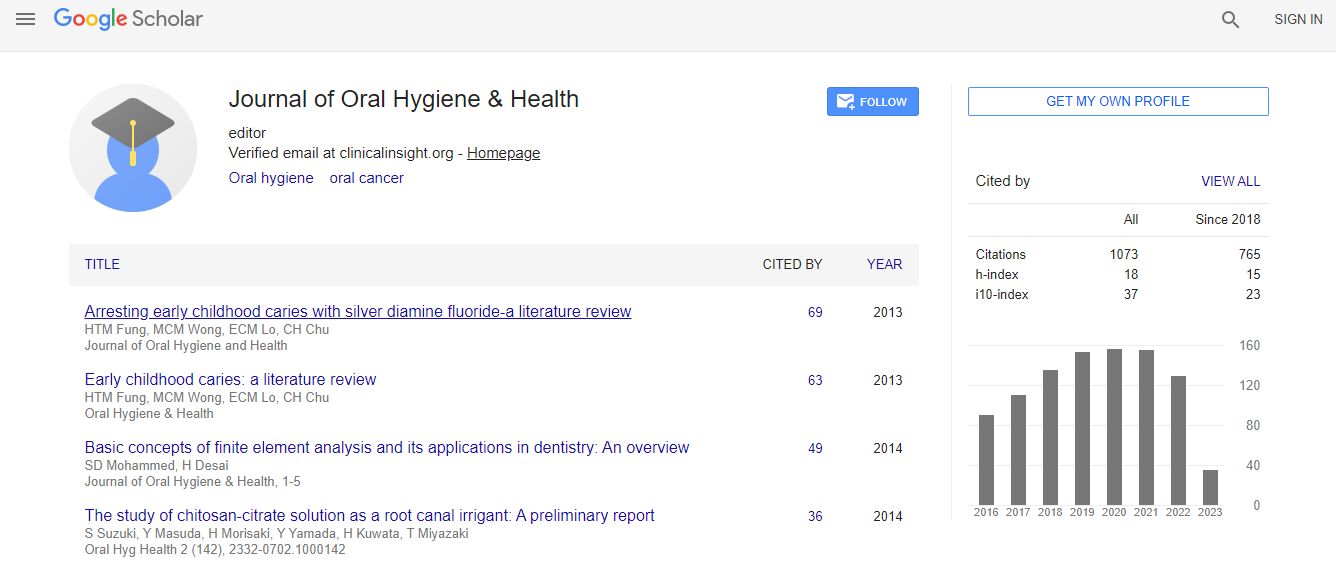Our Group organises 3000+ Global Conferenceseries Events every year across USA, Europe & Asia with support from 1000 more scientific Societies and Publishes 700+ Open Access Journals which contains over 50000 eminent personalities, reputed scientists as editorial board members.
Open Access Journals gaining more Readers and Citations
700 Journals and 15,000,000 Readers Each Journal is getting 25,000+ Readers
Google Scholar citation report
Citations : 1073
Journal of Oral Hygiene & Health received 1073 citations as per Google Scholar report
Journal of Oral Hygiene & Health peer review process verified at publons
Indexed In
- Index Copernicus
- Google Scholar
- Open J Gate
- JournalTOCs
- RefSeek
- Hamdard University
- EBSCO A-Z
- OCLC- WorldCat
- Publons
- Geneva Foundation for Medical Education and Research
- Euro Pub
- ICMJE
Useful Links
Recommended Journals
Related Subjects
Share This Page
War injuries in west of Libya
13th International Conference and Exhibition on Dental Medicine
Mohamed Saleh Elarbi
Ali Omar Askar Neurosurgery Centre, Libya
ScientificTracks Abstracts: J Oral Hyg Health
Abstract
Background: Injuries from different weapons used during war differ from injuries caused by other means to the face. Loss of both hard and soft tissues and damage to vital structures is common in these circumstances. Early intervention and proper management is required for these cases. Objectives: This is a 4 years� retrospective study of patients that sustained firearm induced maxillofacial injuries during war in Libyan Revelations. A total of 41 patients with 55 fractures and isolated soft tissue in 9 cases were treated in Ali Omar Askar Center for Neurosurgery, Maxillofacial Surgery Department Esbea, Tripoli. Patients & Methods: injuries involved were in facial bones and soft tissues such as eyes, lips cheeks and tongue. From Feb. 2011 to December 2014 a total of 41 patients with maxillofacial firearm injuries to soft and hard maxillofacial region were studied. Patients were referred to our hospital with maxillofacial injuries, either after they had the initial treatment elsewhere or had the full management in our hospitals. Including the maxillofacial team, initial assessment and lifesaving procedures for all the accident and emergency cases were applied. Proper clinical and radiographic assessment, antibiotic therapy and wound debridement were done for all the patients and closure using local flaps was given when required. Treatment ranged from immediate intervention to 5 days. Results: The pure soft tissue injuries were in 9 patients (14%), bony fractures involved mostly the mandible in 31 cases (48%): 37 males (90%) and only 4 females (10%) with a ratio of 9:1. The youngest patient was 15 years and oldest one was 60 years. The age groups involved were 21-30 years (44%) followed by 15-20 years (29%) and 31-40 years (24%) with only one patient aged 55 years (2%). 31 patients with mandibular fractures with mainly angle and body fractures constituting 26% and 23% respectively were found. 11 cases of maxillary fractures, 4 cases (36%) of both lefort I and dentoalveolar fractures with 3 cases (27%) involving lateral wall of maxillary sinus were found. 9 cases with isolated soft tissue involvement in the soft tissue around the mandible, forehead two cases each, cheek and tongue 3 cases (33%) were found. Associated injuries such as rupture of eye globe in one case, damage to facial nerve in 2 cases, fractures of cervical spine wing, tongue injury and loss of soft tissue in two cases were also detected. Postoperative wound infection was reported in two cases. Treatments: Open reduction and rigid internal fixation were used in 24 patients out of 44 cases (55%), conservative treatment in 9 cases (20%) and inter-maxillary fixation in 3 cases (7%) were given. Four cases had foreign body removed from soft tissue in head and neck area with or without bony involvement. Conclusion: Maxillofacial gunshot injuries with various types of arms and weapons lead to severe damage to facial bones and orofacial structures. This requires urgent surgical intervention to avoid postoperative infections. In this study, most of the patients did not show up for the follow up and to know the progress of the treatment done.Biography
Mohamed Saleh Elarbi is a renowned Professor in Ali Omar Askar Neurosurgery Centre, Libya. He has many publications to his credit.
Email: mselarbi@hotmail.com

 Spanish
Spanish  Chinese
Chinese  Russian
Russian  German
German  French
French  Japanese
Japanese  Portuguese
Portuguese  Hindi
Hindi 
